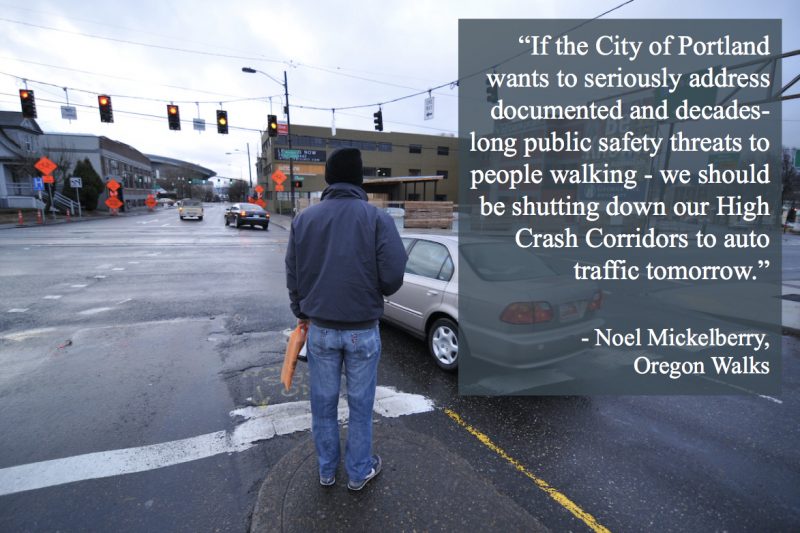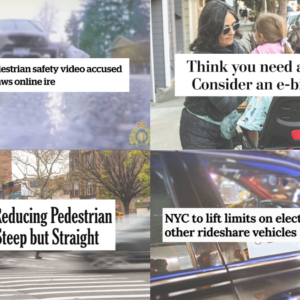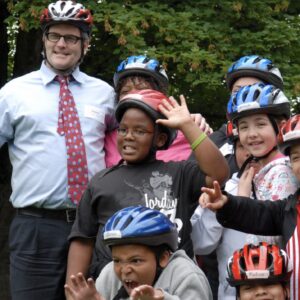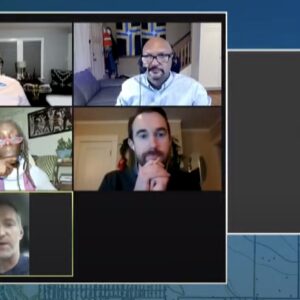
On the same day that 60-year-old Elizabeth Meyers became the 20th person to die while walking on Portland streets this year (the most since 2003), Oregon Walks Executive Director Noel Mickelberry penned a letter to Mayor Ted Wheeler and City Council imploring them to do more — faster — to make our streets more livable.
Here’s the text of Noel’s letter (with her formatting/emphases):
Mayor Wheeler & Portland City Council,
Portland is experiencing a livability crisis in our streets. Today, the 20th person this year was killed while walking. This makes 2017 the deadliest year on record for pedestrians since 2003. Last week, Multnomah County published a new report showing that 80 people died last year while living outside on the streets of Portland. We believe these issues are interconnected and the approach to solving them must take into account numerous factors critical to Portlanders’ safety.
Finding solutions to these growing crises requires a coordinated effort and sustained leadership that recognizes the impacts that every policy and funding decision has on our most vulnerable residents. We have not yet seen the urgency from our City leadership necessary to end this growing epidemic.
Creating safe, walkable communities where people can thrive is at the heart of our work at Oregon Walks. In order to do so, everyone needs access to their basic needs. One of the best ways to achieve this is through investment in safe, walkable, and affordable neighborhoods for everyone, regardless of income, age, background, ability, or housing situation.
Our City leadership must commit to a holistic approach to saving lives on our streets. We have two specific requests for Portland City Council:
Disband the proposed increase of ‘pedestrian use’ zones in downtown Portland as proposed by Mayor Wheeler and defined through his recent op-ed in The Oregonian. We believe that every person has the right to access their community by walking – and for many people living outside, this is the only mode of transportation available. People living outside are also pedestrians, with the same rights to public space as everyone else. And with a dearth of places to sit, public garbage cans, or public restrooms in the downtown core – while offering the densest availability of social services and transit connections – we are leaving our houseless community with very few spaces to simply be. By authorizing enforcement of certain people’s use of public space we are setting a dangerous precedent of determining who has access to basic needs in our city and who doesn’t.
Advertisement
In addition, the visibility of poverty in our city points to the very real public health crisis that deserves resources and attention toward root cause solutions and not reactionary politics. The solution is homes. People need reliable access to jobs, health care, and places to sleep. The time has passed for words of compassion – we need action and we need transparency toward this goal.
Invest in our High Crash Corridors: If the City of Portland wants to seriously address documented and decades-long public safety threats to people walking – we should be shutting down our High Crash Corridors to auto traffic tomorrow. We could literally save lives before the end of December; with dark days and inclement weather ahead, we are too likely to lose another person to traffic violence over the next two weeks.
We have championed Vision Zero in the City of Portland – the policy set to end traffic deaths – with a keen eye toward racial and social equity in its delivery. The City adopted the Vision Zero Action Plan one year ago, and street design – the most critical element – takes a long time to go into effect. It will take even longer if we delay funding opportunities and instead institute stop-gap policies in the name of safety but not in the places or for the people who need it the most. The first major street design investments for Vision Zero will be built in 2018. If we intend to reach our goal of zero traffic fatalities by 2025, we have to move much faster.
The City, with input from the Vision Zero Task Force, has a documented list of projects planned for our High Crash Network and many of them would address the specific locations where lives were lost this year. Implementation needs funding. Funding needs leadership, and our budgets are our moral compass. We need City Council to show that they are committed to their stated policy goals by allocating the necessary funds to reach them.
We encourage a broader conversation about policy changes and investments that will dramatically change the lives of our most vulnerable community members. We welcome the opportunity to discuss solutions to these ongoing public health and safety crises on our streets; the rising number of fatal crashes involving people on foot, and the limited affordability of housing options for everyone in this city we call home. There is so much work to be done.
– Noel Mickelberry
Executive Director, Oregon Walks
— Jonathan Maus: (503) 706-8804, @jonathan_maus on Twitter and jonathan@bikeportland.org
Never miss a story. Sign-up for the daily BP Headlines email.
BikePortland needs your support.





Thank you for saying this Noel.
For every walker killed by motor vehicles four homeless people died on our streets.
There is an obvious and practical solution to homelessness, but not to deaths of walkers and motorists.
We ought to address the more pressing and solvable problem first. That is where our efforts and funding should go.
Not sure why you are for splitting the two. Noel just went to the trouble of linking them, showing how they overlap.
If we have enough money to make war on anyone and everyone, surely we can come up with the will/money/priorities to deal with these two problems that other countries with whom we like to compare ourselves have managed to avoid/solve.
As the mother of a person killed on his bike on a Portland street, road safety is extremely important to me. As a state employee at the public assistance office, I have first-hand knowledge of the many people requesting assistance directly due to the consequences from vehicle collisions. People are unable to work due to their own or family members’ injuries, or their vehicle is totaled and public transportation is inadequate, or the sole breadwinner in the family perished. Often these families/individuals become homeless. Not everyone on the streets fits in this scenario, but they ARE often interconnected. Just my personal experience.
Jim, these two are different sides of the same coin. The “owners” ( George Carlin’s usage) don’t care about anyone who is too poor or marginalized to buy cars and participate in the auto industrial complex, nor do they care about anyone who is too poor or marginalized to participate in the real estate industrial complex. This may sound cynical but I think that deep within some dark room there are those who see pedestrian deaths, and homeless campers as grim lessons to those of us who are scratching to keep a toe-hold in the auto/real estate machine.
I agree insofar as these disenfranchised play a helpless victim role. On the other hand, voluntary self removal from their factory farm immediately draws “concern” and consequences. Trust me on this.
Please outline the “obvious and practical solution to homelessness” that you have in mind. I hope you aren’t suggesting some sort of Swiftian modest proposal, but actually have something real to contribute.
Are you proposing that we kill all homeless people to get rid of them?
“we should be shutting down our High Crash Corridors to auto traffic tomorrow. ”
I’d like to (also) draw attention to this approach.
We need more of this sort of thinking: stark demands for meaningful change that capture the urgency some of us feel around these issues. I think Noel’s words offer a useful counterpoint to the usual mealy-mouthed proposals we hear.
If we simply had a policy of shutting down each road that has a serious injury or death for a year or two, I suspect we’d find that motorists not only behave better, but that they discourage dangerous behavior in order to not lose access to the pavement. It would probably take two or three shut-downs before people got the message, but once they did we’d have vision zero achieved in no time flat.
Sadly, such a policy has almost no role for planners and such, so it’s a non-starter politically.
Treating pavement as an asset and allowing wear as a budgeted item, we should be closing through routes where we’re currently accumulating maintenance debt. This constant refrain that we don’t have the money for sidewalks, bike lanes, or safe crossing should be met with “shut it down”. Cars aren’t a force of nature, and drivers will follow whatever rules we hold them accountable to. This isn’t complicated and it’s not as politically difficult as the ruling class would have us believe.
Then there are the lawsuits for eliminating legal access as required by well established law.
Does city council respond to a letter like this?
All I see is garbage, theft, needles and then more garbage. You folks whine about free parking, but camping for free is just fine. The city looks awful. On my commute home last night I encountered six different pedestrians crossing the street. Everyone was on their device, wearing black and paying ZERO attention to the world around them. Take some responsibility for yourself.
“The city looks awful.”
Yeah, you’re right. Better sweep those camps, make the problem go away…
“You folks whine about free parking, but camping for free is just fine.”
Who’s whining now? With whom exactly are you arguing?
It sounds to me like you are deliberately misconstruing compassion for the less fortunate as stupidity. These days I can think of some more plausible targets for your condescension.
And what are you doing to solve the problem?
Sounds like you did your job of seeing them.
Appreciate this strongly worded letter and agree that the commitment to High Crash Corridors seems to be lacking.
If you look at the projects they have slated most do not have any kind of physical protection. Beaverton-Hillsdale Hwy (Safety Demonstration Project) had buffered MUP/bike/ped lanes painted after a major repaving project earlier this year. There is protection scheduled to be installed next year (at least a year after first being installed) and the other half is depending on paint to protect vulnerable road users. The speed limit is still 40 which, according to all those glossy Vision Zero handouts, means I am (80%) likely dead in the event of a crash on that stretch of road in spite of all the safety measures that were installed.
Barbur Blvd had funding pulled by ODOT due to the SW Corridor project coming in the next 5-20 years. Glisan and Halsey have intermittent facilities that prioritize parking over people, we discussed Hawthorne heading downtown yesterday with the paving project that was recently completed. I could go on with roads that I travel every day (based on what gets posted in the comments these are some of the safer roads) but the story is always the same, people in cars get preferential treatment when it comes to allocating space in the public right-of-way.
True. BH Highway will only get the plastic bollards installed on the north side from Dosch Road to 39th. Those projects are on the way for the first part of 2018 as told by PBOT.
I vividly recall the passionate public testimony at Vision Zero Task Force hearings where grassroots activists repeatedly called for funding to be attached to the strongly worded but financially toothless plan the city council ended up voting. I remember women and people of color standing up and demanding that the city give this plan some financial teeth. City staff made soft cooing noises and “promised” funding at a future date. (We’ve all seen this before have we not.)
After ony of these outreach events had concluded I challenged Commissioner Novick in person. I told him that while I strongly supported the plan, the lack of dedicated funding reminded me of Portland’s long history of failed unfunded plans — including the failed 2030 bike plan. I told Novick that if this plan does not come with a substantial funding committment it would also almost certainly fail as well. Novick became defensive and walked away. Bob Stacey, who was nearby, chastised me for going after Novick because he was an “ally”. I disagree vehemently. Politicians who staff transportation stakeholder groups with city staff, law enforcement, and corporate insiders (who have an FTE-dependent interest in some sort of compromise) are not allies of those who seek reforms that lead to safety, livability, and equity.
For example:
Vision Zero Task Force #1 Meeting — Members in Attendance
Insiders:
Leah Treat, PBOT (chair)
Roger Averbeck, Pedestrian Advisory Committee
Kelly Brooks, ODOT Region 1
Michael Crebs, Portland Police Bureau
Jae Douglas, Multnomah County Health
Lake McTighe, Metro
Michael Morrison, Legacy Emanuel Trauma
Stephanie Noll, The Street Trust
Jeff Owen (for Alan Lehto), TriMet
Don Russ, Portland Fire & Rescue
Bandana Shrestha, AARP
Karis Stoudamire-Phillips, Moda Health
Steven A. Todd, Multnomah County Courthouse
Community advocates/community organizers:
Charles McGee, Black Parent Initiative
David Sale (for Kristi Finney-Dunn), Families for Safe Streets
Thanks, Noel.
I also want to thank Noel for calling attention to the tragic lack of facilities for people living on our streets and people walking on our streets. This neglect of the safety of Portland residents is inexcusable given that we have the resources to remedy it.